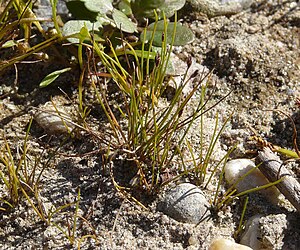Needle rush
| Needle rush | ||||||||||||
|---|---|---|---|---|---|---|---|---|---|---|---|---|

Needle rush ( Eleocharis acicularis ) |
||||||||||||
| Systematics | ||||||||||||
|
||||||||||||
| Scientific name | ||||||||||||
| Eleocharis acicularis | ||||||||||||
| ( L. ) Roem. & Schult. |
The needle rush ( Eleocharis acicularis ), named after its needle-tipped (Latin acicularis ) leaves, also called needle rush or needle rush , is a plant species in the genus swamp rush ( Eleocharis ) within the sourgrass family (Cyperaceae). It is widespread in Eurasia and the New World . This marsh plant is also used in aquaristics .
description
Vegetative characteristics
The needle swamp rush is a wintering green, perennial herbaceous plant that reaches heights of 2 to 15, rarely up to 20 centimeters. It grows with a creeping rhizome , which can be branched and not thickened at the ends, or with runners , turf-shaped . The thread-thin, smooth, light green stems are square and furrowed. There is no leaf blade , the leaf sheaths are purple at the base.
Generative characteristics
The flowering period extends from June to October. 3 to 8, rarely up to 15 flowers are in a 2 to 4, rarely up to 7 millimeters long, 1 to 2 millimeters wide and pointed spikelets together. The bracts are brown and have a white border. The lowest glume encompasses the stem and is not shaped differently from the rest. There are either no or up to four very decrepit perigon bristles , which are up to about half as long as the nuts. The stylus ends in three pits. The nut fruit is ribbed lengthways.
The number of chromosomes is 2n = 20.
ecology
The needle marsh rush is a helomorphic, hydromorphic hydrophyte and hemicryptophyte .
The pollination is carried by the wind ( anemophily ). The female flower organs mature before the male ( proterogyny ).
There is spread of wind or Velcro spread.
Occurrence
The needle rush is widespread in Eurasia and the New World . It is rare in Central Europe , and it is also absent there in certain areas, but it usually forms smaller populations at its locations that develop rapidly between spring and early summer. In Australia she is likely a neophyte .
The coniferous rush thrives best on at least temporarily flooded, moderately nutrient-rich , alkaline and often lime-rich , but mostly lime-poor sand , gravel, clay, mud or scree soils .
The coniferous rush grows preferentially on the flat banks of lakes, alternately dry ponds and backwaters, in ditches and on moist meadows. It occurs in Central Europe in the colline to montane altitude range at altitudes of up to 1000 meters. It prefers locations that are mostly dry and warm in summer from autumn to spring.
In Germany, the main occurrences are in short-lived pioneer soil muddy floors. Eleocharis acicularis is Kennart Association Eleocharitetum acicularis from the association Eleocharition acicularis. It often occurs in contact with companies in the Nanocyperion association. It is also used as an aquarium plant.
The coniferous marsh sedge was rated endangered in the Red List of Endangered Plant Species in Germany in 1996.
Systematics
One can distinguish the following varieties:
- Eleocharis acicularis var. Acicularis : It occurs from the temperate zones of the northern hemisphere to western South America.
- Eleocharis acicularis var. Porcata SGSm .: It occurs from Canada to the United States.
swell
- Siegmund Seybold (Ed.): Schmeil-Fitschen interactive . CD-ROM, version 1.1. Quelle & Meyer, Wiebelsheim 2002, ISBN 3-494-01327-6 .
Individual evidence
- ↑ a b c d e f g h i j k Eleocharis acicularis (L.) Roem. & Schult., Coniferous Swamp. In: FloraWeb.de.
- ↑ a b Erich Oberdorfer : Plant-sociological excursion flora for Germany and neighboring areas . With the collaboration of Angelika Schwabe and Theo Müller. 8th, heavily revised and expanded edition. Eugen Ulmer, Stuttgart (Hohenheim) 2001, ISBN 3-8001-3131-5 , pp. 165 .
- ↑ a b c d e Dietmar Aichele, Heinz-Werner Schwegler: The flowering plants of Central Europe . 2nd Edition. tape 5 : Swan flowers to duckweed plants . Franckh-Kosmos, Stuttgart 2000, ISBN 3-440-08048-X .
- ↑ Christel Kasselmann : aquarium plants. Ulmer Verlag, Stuttgart 1995; 2nd, revised and expanded edition 1999, ISBN 3-8001-7454-5 , p. 284.
- ↑ a b c Rafaël Govaerts (Ed.): Eleocharis acicularis. In: World Checklist of Selected Plant Families (WCSP) - The Board of Trustees of the Royal Botanic Gardens, Kew . Retrieved October 27, 2016.
Web links
- Needle rush . In: BiolFlor, the database of biological-ecological characteristics of the flora of Germany.
- Profile and distribution map for Bavaria . In: Botanical Information Hub of Bavaria .
- Eleocharis acicularis (L.) Roem. & Schult., Map for distribution in Switzerland In: Info Flora , the national data and information center for Swiss flora .
- Distribution in the northern hemisphere from: Eric Hultén , Magnus Fries: Atlas of North European vascular plants 1986, ISBN 3-87429-263-0 at Den virtuella floran (swed.)
- Thomas Meyer: Data sheet with identification key and photos at Flora-de: Flora von Deutschland (old name of the website: Flowers in Swabia )
- Data sheet with photos.
- Flora Vascular datasheet .
- Eleocharis acicularis as an aquarium plant at www.flowgrow.de


